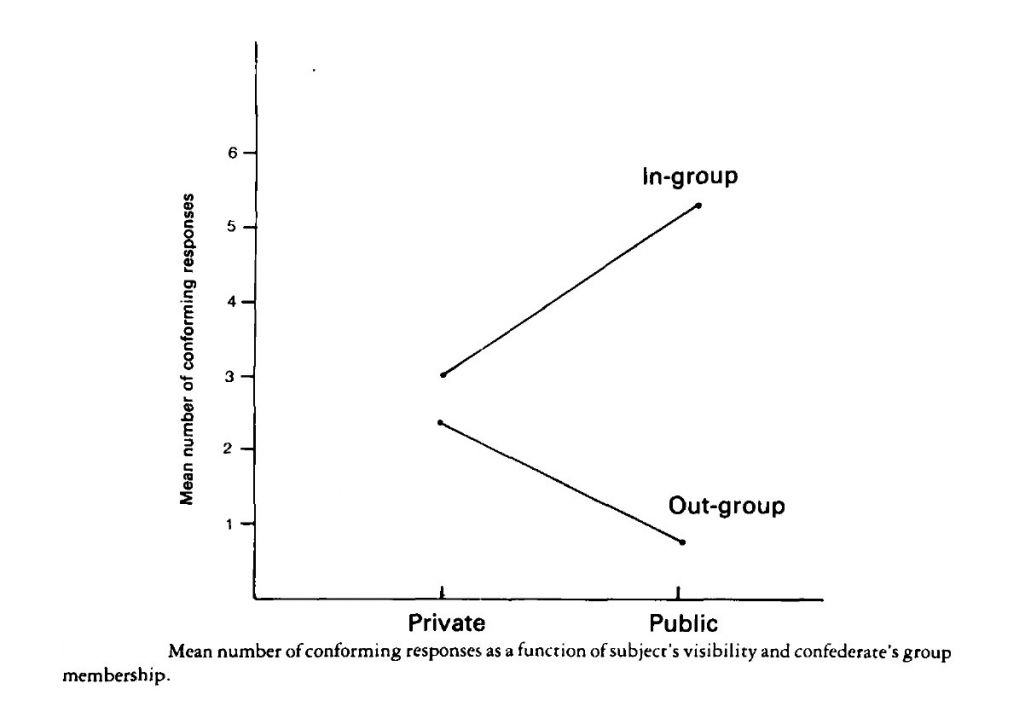Abrams et al (1990)
 Abrams et al (1990) tested the role of social identity on one’s likelihood to conform. The researchers used the basic procedure of the Asch paradigm (though they used computers and projected the lines!), but they looked at the role of in-groups and out-groups on the naïve participant’s behaviour.
Abrams et al (1990) tested the role of social identity on one’s likelihood to conform. The researchers used the basic procedure of the Asch paradigm (though they used computers and projected the lines!), but they looked at the role of in-groups and out-groups on the naïve participant’s behaviour.
The abstract of the original study is available here.
The aim of the study was to determine if in-group identity would affect one's willingness to conform.
Abrams et al (1990) used an independent samples design that included four groups and manipulated two different independent variables. One independent variable was whether the confederates were from an in-group (psychology students) or an out-group (ancient history students). The second independent variable was whether the participant’s responses were public or private. So, it used a 2 X 2 factorial design that looked like this:
| In-group public response | Out-group public response |
| In-group private response | Out-group private response |
Fifty undergraduate students (23 males and 27 females) enrolled in an introductory psychology course participated. At the start of the experiment, the three confederates were introduced either as first-year students from the psychology department of a prestigious university (in-group) or as students of ancient history (out-group) from that same university. The participants were instructed not to talk to each other.
As in the Asch paradigm, the participants were shown a stimulus line, and then three other lines - one of which was the same length as the stimulus line. The task was to identify which of the three lines matched the stimulus line. There were 18 trials. In nine of the trials, the confederates gave the correct response. In nine of the trials, the confederates gave a unanimous, incorrect response.
In each session the confederates and one naive participant sat in a row, facing the monitor. The participant was always placed at one end of the row. The group always gave their judgments in turn, beginning at the opposite end from the participant. In the public condition, all four members of the group gave their judgments aloud, and the experimenter recorded the real participant’s responses. In the private condition, however, the experimenter asked if one of the participants would note down the responses, in order to leave her free to 'operate the computer'. The real participant, who 'happened to be nearest', was asked if he or she would like to record responses. The three confederates then gave their judgments aloud in turn and the real participant recorded their responses on a score sheet along with his or her own, privately.
 Seventy-seven percent of all participants conformed to the erroneous confederate judgments on at least one trial. There were no gender differences observed. The actual proportion of conforming responses was 138 out of a possible 432 (i.e. 32 percent). This is very similar to the results of the original Asch experiments.
Seventy-seven percent of all participants conformed to the erroneous confederate judgments on at least one trial. There were no gender differences observed. The actual proportion of conforming responses was 138 out of a possible 432 (i.e. 32 percent). This is very similar to the results of the original Asch experiments.
Conformity was maximized in the in-group public condition with a mean number of conforming responses of 5.23 and minimized in the out-group public condition (M = 0.75). The in-group private and out-group private conditions did not differ significantly (Ms = 3.00 and 2.33, respectively).
The results seem to indicate that social categorization can play a key role in one’s decision to conform publicly. When compared to Asch’s original findings, the overall conformity levels are about the same. But when we consider social categorization, public conformity exceeded the usual level in the in-group condition but was far below normal in the out-group condition. The explanation for this, from self-categorization theory, is that we tend to exaggerate the difference between us and the out-group, while feeling that members of our own group share a common set of traits. Thus, in this experiment, in-group members may be seen as more correct, while out-group members are seen as less likely to be correct when participants are made conscious of their group membership.
The situation in which the participants found themselves was highly artificial. The study has low ecological validity and may not predict what would happen in a naturalistic situation.
There are ethical concerns about the use of deception.
The manipulation of the independent variable and the high level of control in the experiment allows us to see a causal relationship between group membership and the dependent variable - the rate of conformity to an incorrect response.
The study was made up of university students, so the results may be difficult to generalize. Remember that samples of university students tend to be YAVIS: young, affluent, verbal, intelligent and social.
The study was done in an individualistic society. It is culturally biased.
The study isolates a single variable in order to test its role in conformity; however, in real life there may be several variables that interact to determine conformity behaviours.

 IB Docs (2) Team
IB Docs (2) Team
